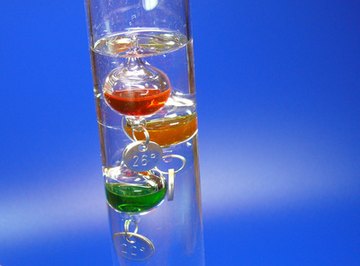
One of the many important observations made by Italian astronomer and physicist Galileo Galilei was that the density of liquid changes -- expands and contracts -- with temperature variation. This observation led to the creation of the Galileo thermometer, a glass tube filled with liquid and liquid-filled glass spheres each with a designated temperature reading.
As the density of the liquid in the tube changes with rising and falling temperatures, the glass spheres rise or sink in relation to those changes, indicating current atmospheric temperature levels. These simple, straightforward and lovely thermometers are as easy to read as they are to set up.
- Galileo thermometer
- Indoor hanging hook (e.g. hanging plant hook)
Hang your Galileo thermometer indoors and from a hook. For the most accurate results, it's best to not hang the thermometer in direct sunlight.
Allow a few minutes for the floating spheres within the thermometer tube to rise and fall according to the current temperature.
As the air temperature changes, the water temperature inside the Galileo thermometer changes, causing the water to either expand or contract and change its density. As the water density changes, some of the spheres will float while others will sink.
Determine the temperature by reading the medallions that are attached to the glass spheres.
The medallions are calibrated counterweights which have a temperature reading imprinted on them. They are what cause the rising and sinking of the spheres. Spheres that sink are heavier than the actual temperature, while spheres that float are lighter than the actual temperature.
The method of determining the temperature varies depending on how the spheres are reacting. If one sphere floats roughly midway in the thermometer tube between a floating and a sinking sphere group, that sphere has the correct temperature reading on its medallion.
If there is no sphere floating midway between the top group of spheres and the bottom group of spheres, take the medallion reading from the lowest sphere in the top group and the medallion reading from the highest sphere in the bottom group, and average the readings from these two to determine the temperature.
When all the spheres float, the temperature is below the lowest sphere. If all the spheres sink, the temperature is above 84 degrees Fahrenheit.
Things You'll Need
References
About the Author
Juan Ramirez has been a writer for over 14 years and worked for two years as an assistant editor with an internationally circulated journal. Ramirez holds a Bachelor of Arts in English writing from Potsdam State University and a Master of Arts in individualized study from New York University.
Photo Credits
thermometer image by bofotolux from Fotolia.com
